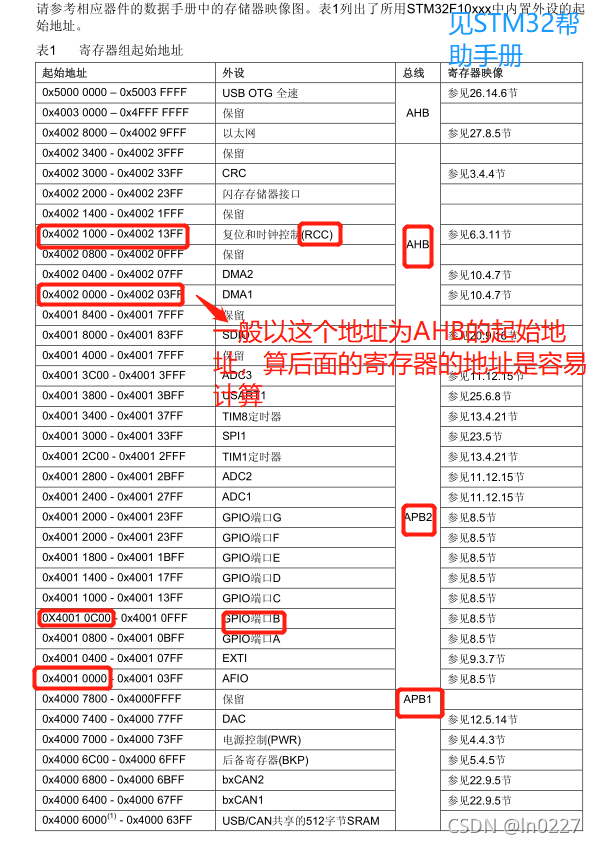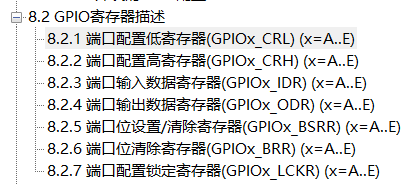使用寄存器映射的方式点亮LED灯
- 第一步,新建工程文件,在《STM32使用寄存器直接地址点亮LED》那篇文章中已经详细的写过了,所以在这里就不在重复的编写了。
- 思路和《STM32使用寄存器直接地址点亮LED》是一样的,都是分为三步:
- [1] 开启时钟。
- [2] 设置端口的输入输出模式。
- [3] 设置端口的输出数值。
但是在《STM32使用寄存器直接地址点亮LED》这篇文章中,当我们需要操作寄存器的时候需要去帮助文件中查找寄存器的地址,并且写地址也不助于代码的可读性,所以我们需要采用寄存器映射的方式来记录下这些寄存器的地址。接下来就是进行寄存器的映射代码的编写 - 寄存器映射代码的编写
从下表可以得到各个寄存器的地址,这样我们进行一个宏定义,把这些地址都以好理解的英文来表示,在后续的使用中我们便可以直接调用英文字母来实现。


编写的宏定义如下:
//这里定义的时候不需要定义为指针的类型
#define DEVICE_BASE_ADRESS (unsigned int )0x40000000
#define APB1_BASE_ADRESS DEVICE_BASE_ADRESS
#define APB2_BASE_ADRESS (APB1_BASE_ADRESS+0x10000)
#define AHB_BASE_ADRESS (APB2_BASE_ADRESS+0x20000)
#define GPIOB_BASE_ADRESS (APB2_BASE_ADRESS+0x0C00)
#define RCC_BASE_ADRESS (AHB_BASE_ADRESS+0x1000)
查找STM32的帮助文档,我们可以找到寄存器相对与GPIOB的偏移地址

从而可以得到寄存器的地址,然后在进行宏定义。
//定义寄存器
#define RCC_APB2ENR *(unsigned int *)(RCC_BASE+0x18)
#define RCC_CR *(unsigned int *)(RCC_BASE_ADRESS+0x00)
#define RCC_CFGR *(unsigned int *)(RCC_BASE_ADRESS+0x04)
#define RCC_CIR *(unsigned int *)(RCC_BASE_ADRESS+0x08)
#define RCC_APB2RSTR *(unsigned int *)(RCC_BASE_ADRESS+0x0C)
#define RCC_APB1RSTR *(unsigned int *)(RCC_BASE_ADRESS+0x10)
#define RCC_AHBENR *(unsigned int *)(RCC_BASE_ADRESS+0x14)
#define RCC_APB2ENR *(unsigned int *)(RCC_BASE_ADRESS+0x18)
#define RCC_APB1ENR *(unsigned int *)(RCC_BASE_ADRESS+0x1C)
#define RCC_BDCR *(unsigned int *)(RCC_BASE_ADRESS+0x20)
#define RCC_CSR *(unsigned int *)(RCC_BASE_ADRESS+0x24)
#define GPIOB_CRL *(unsigned int *)(GPIOB_BASE+0x00)
#define GPIOB_CRH *(unsigned int *)(GPIOB_BASE+0x04)
#define GPIOB_ODR *(unsigned int *)(GPIOB_BASE+0x0c)
#define GPIOB_IDR *(unsigned int *)(GPIOB_BASE+0x08)
#define GPIOB_BSRR *(unsigned int *)(GPIOB_BASE+0x10)
#define GPIOB_BRR *(unsigned int *)(GPIOB_BASE+0x14)
#define GPIOB_LCKR *(unsigned int *)(GPIOB_BASE+0x18)
这样就可以用寄存器的代码来代替《STM32使用寄存器直接地址来点亮LED》文章中的地址符号。
//开启GPIOB的时钟RCC_AHB2ENR
RCC_APB2ENR|= (1<<3);
//设置GPIOB的端口类型GPIOB_CRL
GPIOB_CRL |=(1<<0);
//设置GPIOB的端口的输出\输入值GPIOB_BSRR和GPIOB_BRR
//灯亮
GPIOB_BRR |=(1<<0);
//灯灭
//GPIOB_BSRR |=(1<<0);
但是这只是针对一个端口来说,当对多个端口进行操作时需要定义很多这样的宏定义,所以我们可以继续进行精简,我们可以定义一个GPIO_Type类型的结构体和RCC_TypeDef的结构体,用来存放这些GPIO的寄存器和RCC的寄存器。
typedef unsigned int uint32_t;
typedef unsigned int uint16_t;
typedef struct
{
uint32_t CRL;
uint32_t CRH;
uint32_t IDR;
uint32_t ODR;
uint32_t BSRR;
uint32_t BRR;
uint32_t LCKR;
}GPIO_TypeDef;
typedef struct
{
uint32_t CR;
uint32_t CFGR;
uint32_t CIR;
uint32_t APB2RSTR;
uint32_t APB1RSTR;
uint32_t AHBENR;
uint32_t APB2ENR;
uint32_t APB1ENR;
uint32_t BDCR;
uint32_t CSR;
}RCC_TypeDef;
然后在把GPIOB_BASE_ADRESS转化为GPIO_TypeDef类型的变量把RCC_BASE_ADRESS 转化为RCC_TypeDef类型的变量,作为结构体的首地址。
#define GPIOB ((GPIO_TypeDef *)GPIOB_BASE)
#define RCC ((RCC_TypeDef *)RCC_BASE)
这样就可以通过调用结构体的方式来进行相应的操作。
//配置GPIOB端口的时钟
RCC->APB2ENR |= (1<<3);
//配置IO口为推挽输出模式,速度为10MHz
GPIOB->CRL &=~((0x0f)<<0);
GPIOB->CRL |=(1<<0);
//配置PB0口输出0
GPIOB->ODR &=~(1<<0);
GPIOB->ODR |=(1<<0);
- 下载程序,灯被点亮。